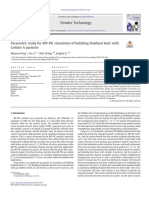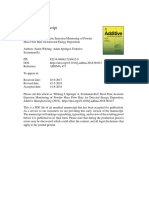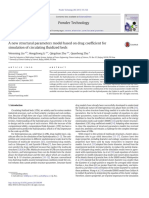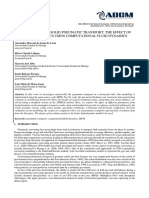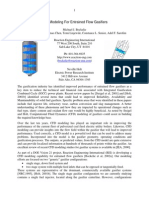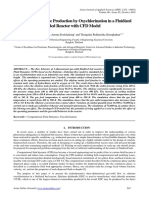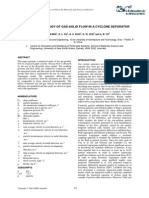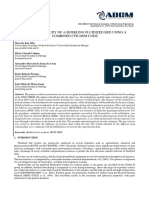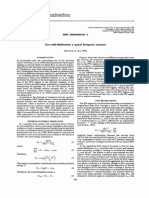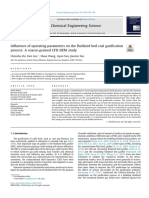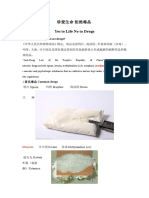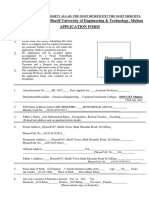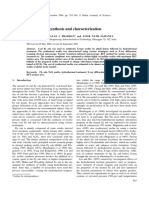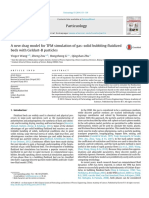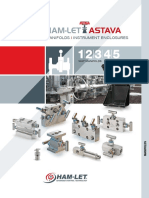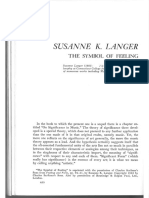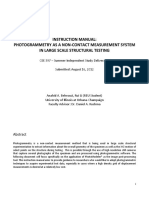Authors Accepted Manuscript
Improvement of EMMS Drag Model for
Heterogeneous Gas-Solid Flows based on Cluster
Modelling
Chen Cheng, Dai Qunte, Qi. Haiying
www.elsevier.com/locate/ces
PII:
DOI:
Reference:
S0009-2509(15)00698-3
http://dx.doi.org/10.1016/j.ces.2015.10.025
CES12646
To appear in: Chemical Engineering Science
Received date: 11 May 2015
Revised date: 11 October 2015
Accepted date: 21 October 2015
Cite this article as: Chen Cheng, Dai Qunte and Qi. Haiying, Improvement of
EMMS Drag Model for Heterogeneous Gas-Solid Flows based on Cluster
M o d e l l i n g , Chemical
Engineering
Science,
http://dx.doi.org/10.1016/j.ces.2015.10.025
This is a PDF file of an unedited manuscript that has been accepted for
publication. As a service to our customers we are providing this early version of
the manuscript. The manuscript will undergo copyediting, typesetting, and
review of the resulting galley proof before it is published in its final citable form.
Please note that during the production process errors may be discovered which
could affect the content, and all legal disclaimers that apply to the journal pertain.
�Improvement of EMMS Drag Model for Heterogeneous Gas-Solid
Flows based on Cluster Modelling
Chen Cheng, Dai Qunte, Qi Haiying
Key Laboratory for Thermal Science & Power Engineering of Ministry of Education,
Tsinghua University, Beijing 100084, P.R. China
Abstract
Cluster sub-models are developed and combined with the Energy minimum multiscale
method (EMMS) drag model to improve drag predictions for heterogeneous gas-solid flows.
Theoretical cluster sub-models are developed to relate the cluster parameters with the local
solid volume fraction. The cluster sub-models are validated by experimental data in the
literatures. Drag coefficients predicted by the modified EMMS model with cluster sub-models
are much lower than previous EMMS results and agree well with the experiment-based model.
At solid volume fractions between 0.1 and 0.15 the drag coefficient, , reaches a minimum at
a maximum for slip velocities and gradually increases towards both sides to that of uniform
flow. The modified EMMS drag model is further verified by CFD simulations of gas-solid
flows in a CFB riser by coupling with the two-fluid model. The verification of the modified
EMMS model once again demonstrates the applicability of the cluster sub-models.
Key words: cluster, drag model, EMMS method, heterogeneous gas-solid flows
1. Introduction
Computational fluid dynamics (CFD) is an effective tool for understanding the
fundamentals of gas-solid flows and for the design and scaling of fluidized systems.
The two-fluid model based on kinetic theory for granular flows is the most widely
used among the numerous numerical studies on gas-solid flows. The two-fluid model
is especially applicable due to its computational simplicity for large fluidized systems
with large numbers of solid particles.
Corresponding author Tel. /Fax: +86 10 62796036. E-mail address: hyqi@mail.tsinghua.edu.cn.
1
�However, a major challenge for CFD models of heterogeneous gas-solid flows is
to realistically resolve the effect of clusters on the gas-solid interaction, i.e. the drag
force. Particle clusters continuously form and break in heterogeneous flows,
especially for small particles such as Geldart A particles. The clustering of particles
results in a heterogeneous solid distribution, with high gas-solid slip velocity and
remarkable drag reduction (Bai, et al. 1999; Jiradilok et al. 2006; Zhu & Zhu, 2008).
Quantifying the clusters and their effects on the drag is critical for the realistic
simulations of heterogeneous gas-solid flows.
Drag models which take into account the cluster effects are called sub-grid
models. OBrien and Syamlal (1993) gave an experimental sub-grid drag model that
worked well. Although the model was limited to only two solid mass fluxes due to an
empirical factor, it could be used to evaluate other numerical models (Qi, 1997; Chen,
Li, & Qi, 2012). Besides the empirical model types, such as the scaling factor method
and the cluster size-based method, the two main types of sub-grid drag models are the
correlative multiscale method (Van der Hoef et al., 2006) and the Energy
Minimization Multi-Scale (EMMS) method (Li & Kwauk, 1994; Wang, 2009). In this
study, the sub-grid drag model is based on the EMMS method since it has a more
reliable theoretical foundation.
The theoretically based EMMS method has successfully predicted the drag
reduction in heterogeneous gas-solid flows. Some EMMS-based drag models have
been developed and coupled with CFD method to predict the drag (Xiao et al., 2003;
Yang et al., 2003; Wang and Li, 2007; Wang, Ge, & Li, 2008; Li et al., 2011; Shah et
al., 2011). The EMMS-based drag model improved the accuracy of heterogeneous
gas-solid flow predictions in CFB risers (Wang, 2010; Lu et al., 2012; Nikolopoulos
et al., 2010). However, validation inside the CFD framework could disguise the drag
�model defects (Naren et al., 2007). The description of cluster parameters is still a
problem which results in inaccurate drag coefficients (Wang et al., 2013).
The EMMS model has two cluster parameters, the volume fraction in clusters
and the cluster diameter. Cluster diameter is generally believed to be significant in
the EMMS model, while very few studies have paid attention to the importance of the
solid volume fraction in clusters. Different cluster diameter correlations have been
used in the EMMS model with the correlation proposed by Harris et al. (2002) giving
more reasonable results (Shah, 2011). However, the cluster diameter of Harris et al.
(2002) is actually the mean vertical cluster length which is quite different from the
surface volume mean diameter of an equivalent spherical cluster in the EMMS
method. The cluster sizes in experimental investigations usually refer to the mean
vertical cluster length because of the considerable variation of cluster shapes (Qi,
2003; Qi et al., 2005). Thus, more attention should be paid to the physical definition
when employing a cluster diameter correlation.
The solid volume fraction in clusters in the original EMMS model was assumed
to be constant, equivalent to the solid volume fraction at the minimum fluidization. In
the latest EMMS model, the solid volume fraction in clusters was solved by searching
in a physical extent to minimize the suspension and transport energy (Wang and Li,
2007; Li et al., 2011). However, the predicted solid volume fraction in clusters
disagreed with experimental measurements. Experimental investigations indicated
that the solid volume fraction in clusters is closely related to the local solid volume
fraction (Yang and Leu, 2009; Guenther and Ronald, 2007; Manyele et al., 2002;
Sharma et al., 2000; Xu and Zhu, 2011). However, they have not been able to provide
a credible correlation for the solid volume fraction in clusters. There is little
experimental data for large local solid volume fractions due to measurement
�difficulties. Also, the experimental data varies greatly in different CFB facilities and
for different operating conditions (Bai et al., 1993; Bi and Grace, 1995). Theoretical
analyses provide another tool to investigate cluster parameters with experimental data
for verification.
This study combines the Energy minimum multi-scale method (EMMS) drag
model with cluster sub-models. The sensitivity of the drag to the solid volume
fraction in clusters and the cluster diameter are analyzed to describe the cluster
effects. Theoretical cluster sub-models are developed which relate the cluster
parameters to the local solid volume fraction. The sub-model is then introduced into
the EMMS method to complete the drag model. The cluster sub-models and the
modified EMMS drag model are compared to experimental data in the literature for
verification. The modified EMMS drag model is then coupled with the two -fluid
model to calculate the gas-solid flows in a CFB riser.
2. EMMS-based drag model
The basic idea of EMMS method is that a heterogeneous flow system can be
divided into three uniform sub-systems, the particle-rich dense phase or cluster, the
gas-rich dilute phase and their interaction phase. The suspension and transport energy
should be at a minimum when the system is at steady state.
2.1 QL-EMMS model
The QL-EMMS model was recently developed with no assumptions. It contains
10 state variables, 7 basic equations and 1 steady state condition (Li et al., 2011).
State variables:
X=( sc , sf ,U gc ,U gf ,U sc ,U sf , f ,dcl ,ac , a f )
(1)
Mass balance equations:
�Gas
U g U gf 1 f U gc f
(2)
Solid
U s U sf 1 f U sc f
(3)
Momentum balance equations for particles:
Dense phase
fnc Fc ni Fi f sc s g ac g
(4)
Dilute phase
n f Ff sf s g a f g
(5)
Pressure balance between the dense phase and the dilute phase:
p / h f p / h i / 1 f p / h c
p / h k nk Fk ,
(6)
k c, f , i
Hydrodynamic equivalent cluster diameter:
U
U
s
U mf mf s g
1 mf
1 max
d cl
dp
mf U s
s
N st
U
g
s g mf 1 mf
(7)
Overall solid volume fraction:
s f sc 1 f sf
(8)
Steady state condition:
N st min
N st
s g
gf gc 2
g U g
f 1 f U gf
s
1 g
(9)
With these definitions, the drag coefficient, , is given by
g
ur
FD =
fnc Fc 1 f n f Ff ni Fi
ur
(10)
ur =
Ug Us
-
g s
2.2 QL-EMMS model solution
The QL-EMMS model is solved using a two-step method as shown in Fig. 1 (Wang and
Li, 2007; Li et al., 2011). In the first step, the variations of the state variables with the local
5
�solid volume fraction are calculated for the overall operating conditions. The predicted
relationships of the solid volume fraction in clusters, sc, and the cluster diameter, dcl, with the
local solid volume fraction, s, are used in the second step. The variations of the state
variables including drag coefficient with both the local solid volume fraction and the slip
velocity are obtained in the second step. The local flow parameters provided by the CFD
simulation are then used to determine the drag coefficient which is sent back to the CFD
framework for the next-step simulation. The voidage in the dilute phase, gf, was found to be
constant at the maximum voidage of 0.9997, the maximum voidage at which no clusters exist
(Matsen, 1982). Thus, the voidage was set to 0.9997 in the subsequent calculations to save
computing time.
Figure 2 shows the profiles of the cluster parameters and drag coefficient obtained from
the first step of the QL-EMMS model. For comparison, Fig. 2a also shows the results of a
traditional drag model for uniform flow, Curve Uniform (Syamlal and OBrien, 1988), a
sub-grid model deduced from direct numerical simulations, Curve DNS (Wang, Liu, & You,
2011) and a sub-grid model based on experiments, Curve O-S (OBrien and Syamlal, 1993).
The simulation conditions are the same unless otherwise specified: Ug=3.7 ms-1, Gs=98
kgm-2s-1, s= 1714 kg m-3, dp=76 m, g=1.205 kg m-3, g=1.81510-5 Pas and smf=0.6.
In Fig. 2, the QL-EMMS drag coefficient more accurately captures the drag reduction
due to the heterogeneous structure than the uniform model. However, the drag reduction
magnitude is relatively small and still differs greatly from the other two sub-grid models. The
DNS and O-S drag coefficients show the same characteristic, reaching minimum at the local
solid volume fraction of about 0.1 and approaching to the uniform result at both large and
small local solid volume fractions. The singular point around 0.1 of DNS curve is due to the
assumption of heterogeneous solids distribution (Wang, Liu, & You, 2011). In contrast, the
QL-EMMS drag coefficient increases throughout the entire range with the local solid volume
�fraction until exceeds the uniform result. Also there is a sudden turning point at s=0.45 which
has no physical meaning. The errors are likely due to the inaccurate description of the cluster
parameters, since the clusters cause the heterogeneous structure and drag reduction. In
addition, the drag coefficient depends heavily on the cluster parameters founded in the first
step in the two-step process. Comparing Fig. 2a and b, the inflection point in the QL-EMMS
drag coefficient at the local solid volume fraction of 0.45 corresponds to the inflection points
of the cluster parameters. After the inflection point, the solid volume fraction in clusters
remains constant and the cluster diameter decreases, leading to a strongly increasing drag
coefficient. Hence, the drag coefficient is closely related to the cluster parameters.
3. Relationship of the clusters with the slip velocity
As is well known, the clusters result in high gas-solid slip velocities, much higher than
the solid terminal velocity because the gas tends to flow around the clusters rather than
through clusters which reduces the flow resistance. Thus, the slip velocities must be closely
related with the cluster parameters.
The relationship between the slip velocity and the cluster parameters can be anticipated
from the relationship between the solid terminal velocity and particle parameters, since the
slip velocity in homogeneous flow is close to the solid terminal velocity according to the
classification of homogeneous/aggregative fluidization. As is well known, the larger particle
densities or diameters result in larger solid terminal velocities (Haider and Levenspiel, 1989).
Thus, the slip velocity in heterogeneous flow should increases with increasing cluster density
and diameter. The cluster density is represented by the solid volume fraction in clusters for a
given gas and particles,
cl s sc g 1 sc
(11)
Experimental measurement of the local slip velocity show that, it is not uniformly
distributed in the radial direction of CFB risers but reaches a maximum at the core-annulus
�boundary where severe particle clustering exists (Yang et al., 1992; Tanner et al., 1994). The
measured slip velocities (Qi, 1997) are plotted with dependent against the local solid volume
fraction in Fig. 3. The profiles for different operating conditions all have single peak with the
maximum slip velocity located between solid volume fractions of 0.1 and 0.15, indicating
severe particle clustering there. Therefore, the solid volume fraction in clusters and the cluster
diameter are indicated to be the largest in that region. The slip velocities decrease on both
sides of the local solid volume fraction. It is indicated that more homogeneous flow with
gradual disappearance of clusters towards more dilute solid concentration; while for higher
local solid volume fractions from slugging and bubbling fluidization conditions to near
minimum fluidization, low slip velocities with homogeneous flow conditions are reached.
4. Cluster sub-models
This section gives cluster sub-models which describe the relationships of the cluster
parameters with the local solid volume fraction.
4.1 Sub-model for the solid volume fraction in clusters
The solid volume fraction in clusters is larger than the local solid volume fraction, s, and
less than or equal to the solid volume fraction at minimum fluidization, smf. A heterogeneity
index, , that ranges from 0 to 1 can be defined as,
sc - s
smf - s
(12)
As a result of that the particle clustering would reach the most severe state at s=0.1-0.15,
the profile of should indicate a unimodal distribution with the maximum located between
the local solid concentrations of 0.1 and 0.15. gradually decreases to zero from the
maximum to both sides. For reaching a maximum at s equal to 0.15 and approaching zero
at s equal to 0.0003 (1-max) and 0.6 (smf), can be expressed as
30.5 s 2
15.37 s +0.03
0.96
(13)
The distribution of with the local solid volume fraction is plotted in Fig. 4. The
corresponding solid volume fraction in the cluster was given by Eq. 12 and was plotted in Fig.
5. The dashed line with a slope in Fig. 5 represents the homogeneous state because the
so-called cluster density equal to the particle density and sc exactly equals the local solid
volume fraction. The profile of sc varies between the two dashed lines representing the
uniform state and the minimum fluidization state as shown in Fig. 5.
4.2 Sub-model for the cluster diameter
The cluster diameter is always larger than the particle diameter in heterogeneous flows
and they are equivalent in uniform flows since there are no clusters. The cluster diameter
should reach a maximum in the region where the local solid volume fraction is between 0.1
and 0.15 and should then decreases to the particle diameter from this maximum towards both
sides. Therefore, the cluster diameter correlation in the EMMS method in Eq. 7 is modified
using the heterogeneity index .
d cl = d cl-EMMS +d p
U
s
U mf mf s g
max
mf
=
+1 d p
U
s
N st
U mf mf s g
s g
1 mf
(14)
In this way, the maximum cluster diameter is actually calculated by the EMMS model
and the cluster diameter automatically approaches the particle diameter when the local solid
volume fractions are close to zero or smf.
4.3 Verification of the cluster sub-models
(1) Solid volume fraction in clusters
�The correlations for the solid volume fraction in clusters expressed by Eqs. 12 and 13 are
verified against experimental data (Nicolai et al., 1993 and Zhang, 1992 from Harris et al.,
2002) in the literature in Fig. 6. In the original paper of Harris et al., (2002), the experimental
data are plotted in the double logarithm coordinates, suggesting a fitting function with
monotonically increasing trend. When the same experimental data are plotted in the linear
coordinate system in Fig. 6, the solid volume fraction in clusters first increases and then tends
to decrease with the local solid concentration. The theoretical model of solid volume fractions
in clusters agree well with the experimental data. Both the calculated and measured sc first
increase and then gradually decrease with increasing local solid volume fraction. There is
little experimental data at local solid concentrations larger than 0.3 due to measurement
difficulties (Tanner, 1994). The QL-EMMS result is also plotted in Fig. 6 for comparison. The
profiles of sc predicted by Eqs. 12 and 13 agree better with the experimental data than the
QL-EMMS result.
(2) Cluster diameter
Experimental investigations have shown that the cluster diameter increases with the local
solid volume fraction and tends to infinity, even 108 times the particle diameter. However, the
cluster diameter should be limited within some range, at least not exceeding the CFB riser
diameter. Furthermore, measured cluster diameters refer to the mean vertical cluster length
which is quite different from the sphere cluster equivalent diameter in this study. Therefore,
experimental measurements of cluster diameters are not suitable for comparison and the
cluster diameter correlation will be verified indirectly by comparing with an drag coefficient.
5. Modified EMMS drag model with the cluster sub-models
The cluster sub-models are introduced to modify the EMMS drag model. The solid
volume fraction in clusters is calculated using Eqs. 12 and 13 instead of assuming a constant
value as in the original EMMS model or by the search method in the QL-EMMS model. The
10
�original cluster diameter expression is then replaced by the correlation in Eq. 14. Thus, the
cluster sub-models introduce one supplementary equation and one modified equation into the
EMMS drag model. The modified EMMS model then has 10 variables, 8 equations and 1
steady state condition.
The results of the first step of the modified EMMS drag model are compared with that of
the QL-EMMS model in Fig. 7. Figure 7a shows that the solid volume fraction in clusters
predicted by sub-models is much larger than the QL-EMMS result at s less than 0.31 and
then gradually decreases to the uniform result. Figure 7b shows that the modified cluster
diameter is quite large between s of 0.1 and 0.3, and decreases to the particle size on both
sides. The maximum location is shifted to a smaller s than for the QL-EMMS cluster
diameter because the present correlation is modified by the heterogeneous index whose
maximum is at s equal to 0.15. The modified cluster diameter is smaller than the QL-EMMS
result because is less than 1.
Figure 7c compares the drag coefficients for the various drag models. The modified
EMMS model has no solution at s larger than 0.42 because the superficial slip velocity Uslip
(Ug0-Upg/s) is negative leading to negative suspension and transport energy. Figure 7c
further shows that the drag coefficient of the modified EMMS model successfully captures
the key features of the experimental O-S result. The drag coefficients decrease to a minimum
at s near 0.1 and then gradually increase to the homogeneous state. The comparison of the
results of the modified EMMS model with the QL-EMMS model in Fig. 7a, b and c show that
the sc of the modified model is larger for s less than 0.31 leading to lower drag coefficients,
even though the smaller cluster diameter in Fig. 7b should lead to larger drag coefficients.
This indicates once again that the drag coefficient is more sensitive to the solid volume
fraction in clusters than the cluster diameter.
11
�The comparison between uniform and heterogeneous drag models can be better
illustrated by a correction factor, Hd, which represents the differences between the uniform
and heterogeneous flow characteristics.
Hd =
heterogeneous
uniform
(15)
Figure 7d illustrates the variation of this correction factor with the local solid volume
fraction. The correction factor calculated from the modified EMMS model decreases much
more than that of the QL-EMMS model and is in reasonable agreement with the O-S result.
The minimum correction factor of the modified EMMS model is located at the same s as the
O-S result, while that of the QL-EMMS model is located at a much larger s of 0.45. This
verification of the modified EMMS drag model once again shows the reasonability of the
cluster sub-models.
Figure 7d further shows that at the left side of the curve calculated from the modified
EMMS model, the correction factor increases to unity with decreasing local solid volume
fraction, indicating the disappearance of clusters at large voidage. At the right side of the
curve, the correction factor increases with increasing local solid volume fraction and
gradually tends to a constant. Although the constant exceeds unity which is unrealistic, the
curve exhibits the same tendency as the O-S result. Correction factors larger than unity must
be reduced to unity for CFD simulations since it cannot be larger than unity.
The quantitative difference between the correction factors calculated from the modified
EMMS model and the O-S result is due to the difference in the slip velocity. The O-S model
is a heterogeneous drag model developed from experiments, which can be used as a
benchmark for theoretical drag models. However, O-S model was derived from special
experimental operating conditions as shown in Fig. 7. So the O-S model can only apply well
at this condition and is not applicable to other conditions. Qi (Qi, 1997) investigated the
12
�applicability of O-S model on many other operating conditions and showed a big deviation
between the experimental results and the simulation by the O-S mode. The drag model
proposed in the present work was based on EMMS theory improved by the cluster sub-models,
which can be applied at different conditions including slip velocity and operating conditions.
The correction factors for various local solid volume fractions and slip velocities
calculated in the second solution step given in Sec. 2.2 are plotted in Fig. 8. The variation of
the correction factor with the solid volume fraction is a surface rather than a curve because of
the influence of the slip velocity. Thus, the drag coefficient or the correction factor is related
to both the local solid volume fraction and the slip velocity.
6. Coupling the modified EMMS model with CFD models
The modified EMMS drag model was further verified by CFD simulation of gas-solid
flows in CFB risers coupled with the two-fluid model.
6.1 Governing Equations
Mass balance:
k k k k uk 0
t
k g, s
(16)
s g 1
(17)
g g ug g g ug ug g p g g g g Hd Wen-Yu ug us
t
(18)
s sus s susus sp ps s s s g H d Wen -Yu ug us
t
(19)
Momentum balance:
The correction factor, Hd, in Eqs. 18 and 19 was given by the modified EMMS model as
shown in Fig. 8. The relationship between Hd and the local solid volume fraction and slip
velocity in Fig. 8 could be used to determine Hd in the EMMS drag model for any element as
a function of the local flow parameters provided by the CFD simulation for the next step of
13
�the CFD simulation. The simulation here used the commercial software FLUENT with User
Defined Functions.
6.2 Simulation conditions
The simulation conditions are the same as that in Lu et al. (2009) for the comparison of
the results calculated by the improved EMMS drag model in this study and the results in the
literature. Figure 9 shows the 2D schematic configuration of the simulated riser. The elements
were distributed uniformly with a number of 40300. The superficial gas velocity was
specified to 1.52 m/s at the bottom inlet with atmospheric pressure specified at the upper
outlet. The solids which have densities of 930 kg/m3 and diameters of 54 m were initially
packed at the bottom of the riser with a height of 1.855 m and an incipient solid volume
fraction of 0.5. The solids were carried up by air and the outflow solids were fed back into the
riser from the sidewall inlets to assure a constant solids inventory in the riser. The no-slip
boundary condition was used for the gas phase. The partial-slip boundary condition was used
for the solid phase with a specularity coefficient of 0.0001 (Benyahia, 2012). A time step of
510-4 s was used and the time-average statistics were carried out for the last 10 s. Other
parameter settings can be found in Lu et al. (2009) and are not listed repeatedly in this paper.
6.3 Simulation results and analysis
The simulation accuracy for the specified gas velocity and solid inventory can be
verified through the solids circulation mass flux. The solid mas flux at the top outlet is plotted
in Fig. 10. The time-averaged solid mass flux is 21.3 kg/m2s and agrees better with the
experimental result of 14.3 kg/m2s than that in Lu et al. (2009) where it was 167.16 kg/m2s
and 28.04 kg/m2s calculated by the Gidaspow model and the EMMS/Matrix model
respectively. Thus, the modified EMMS drag model with cluster sub-models effectively
improves the simulation accuracy.
14
�Figure 11 shows the computed time-averaged solid volume fractions in the riser. The
upper part above 8 m height is also plotted with smaller color scope. The heterogeneous solids
distribution structure is successfully captured, exhibiting the bottom-dense and upper-dilute
structure in the axial direction and the core-annular structure in the radial direction. The solids
concentration at the height of 10.08 m is relatively large due to the sidewall outlets.
Figure 12 compares the computed and measured axial profiles of the time-averaged
cross-sectional mean solid volume fraction. The calculated profile using the modified EMMS
drag model in this study shows better agreement with the experimental data than that in Lu et
al. (2009). The S-shape profile is successfully captured and the predicted transition height is
about 4 m which is the same as the experimental result while that in Lu et al. (2009) is much
higher ( 8 m). Some deviation from the experimental data is partially due to the inaccurate
solid stress and boundary effects which are also affected by clusters.
Figure 13 shows the radial distributions of the time-averaged solid volume fraction and
slip velocity, i.e. the relative vertical velocity between gas and solids, at different heights. The
core-annulus structure is successfully predicted with large solid concentration near the wall
and small solid concentration in the core region. The solids are more likely to be carried
upward by the gas in the core region with large slip velocities much higher than that in the
annulus region. The slip velocity decreases with increasing height since the solids are
accelerated along the height. These show that the modified EMMS drag model successfully
captures the heterogeneous flow structure in CFB risers.
Figure 14 shows the local slip velocity as a function of the local solid volume fraction at
the same location in the riser. The results in definite height range are plotted with the definite
color. Although the slip velocity changes with the riser height and radial location even at the
same solid volume fraction, the overall trend agrees well with the experimental results in Fig.
3. The slip velocity reaches maximum at the local solid volume fractions between 0.1 and
15
�0.15 and decreases from the maximum towards both sides. The slip velocity decreases with
increasing height even at the same local solid volume fraction because the solids are
accelerated by gas along the height. Therefore, the modified EMMS drag model with cluster
sub-models is validated to be applicable for simulating gas-solid flows in CFB risers.
7. Conclusions and prospects
(1) Cluster sub-models which relate the cluster parameters to the local solid volume fraction
has been developed from a theoretical analysis and verified by experimental data available
in the literature. The solid volume fraction in clusters ranges between two straight lines
with one line representing the uniform state and the other representing the minimum
fluidization state. The maximum solid volume fraction in clusters occurs at a local solid
volume fraction of 0.15 and changes with the operating conditions. The solid volume
fraction in clusters gradually decreases from the maximum to the line with slope one on
both sides. The cluster diameter correlation in the EMMS method is also modified so that
the cluster diameter approaches the particle diameter at extremely large and small local
solid volume fractions where the clusters gradually disappear.
(2) The EMMS-based drag model was modified by introducing cluster sub-models. The drag
coefficients predicted by the modified EMMS model then agree well with those of the
experimental O-S model. The verification of the modified EMMS model demonstrates the
accuracy of the cluster sub-models.
(3) The modified EMMS drag model was further verified by CFD simulations of gas-solid
flows in CFB risers using the two-fluid model. The solids circulating mass flux, as well as
the axial and radial heterogeneous flow structures, are successfully predicted.
Acknowledgements
This study was financially supported by the National Natural Science Foundation
of China under Grant No. 91334111.
16
�Nomenclature
a
particle acceleration (ms -2 )
d cl
cluster diameter (m)
dp
particle diameter (m)
volume fraction of the particle dense phase (-)
drag force of a single particle (N)
gravitational acceleration (ms -2 )
Gs
solid mass flux (kgm -2 s -1 )
riser height (m)
H0
n
N st
initial bed storage height (m)
particle number density (1/m 3 )
suspension and transport energy (Jkg-1 )
pressure (kPa)
real velocity (m/s)
apparent velocity (m/s), U k =u k k , k=g, s, r
Greek letters
drag coefficient (Nsm -4 )
density (kgm -3 )
dynamic viscosity (Pas)
volume fraction (-)
heterogeneity index
Subscripts
c
particle dense phase
particle dilute phase
interaction phase
gas phase
solid phase
universal index, =g, s, r, c, f, i
mf
minimum fluidization
17
relative parameter for the gas and solid phases
18
�References
Bai, D., Issangya, Y.S., & Grace, J.R. (1999). Characteristics of gas-fluidized beds in
different flow regimes. Ind. Eng. Chem. Res., 38, 803-811.
Bai, D., Jin, Y., & Yu, Z. (1993). Flow regimes in circulating fluidized beds.
Chemical Engineering & Technology, 16, 307-313.
Benyahia, S. (2012). Analysis of model parameters affecting the pressure profile i n a
circulating fluidized bed. AIChE Journal, 58, 427-439.
Bi, H. T., & Grace, J. R. (1995). Flow regime diagrams for gas-solid fluidization and
upward transport. International Journal of Multiphase Flow, 21, 1229-1236.
Chen, C., Li, F., & Qi, H.Y. (2012). Modeling of the flue gas desulfurization in a
CFB riser using the Eulerian approach with heterogeneous drag coefficient .
Chemical Engineering Science, 69, 659-668.
Guenther, C., & Ronald, B. (2007). Wavelet analysis to characterize cluster dynamics
in a circulating fluidized bed. Powder Technology, 173, 163-173.
Haider, A., & Levenspiel, O. (1989). Drag coefficient and terminal velocity of
spherical and nonspherical particles. Powder technology, 58, 63-70.
Harris, A.T., Davidson, J.F., & Thorpe, R.B. (2002). The prediction of particle cluster
properties in the near wall region of a vertical riser. Powder Technology, 127,
128-143.
Jiradilok, V.D., Gidaspow, S., Damronglerd, W.J., Koves, R., & Mostofi (2006).
Kinetic theory based CFD simulation of turbulent fluidization of FCC particles
in a riser. Chemical Engineering Science, 61, 5544-5559.
Li, F. Chen, C., Wang, J.S., & Qi, H.Y., (2011). QL-EMMS drag model for dense
gassolid flow and its improvement. Journal of Engineering Thermophysics, 32,
75-79.
19
�Li,
J.H.,
&
Kwauk,
M.
(1994).
Particle-fluid
two-phase
flow:
the
energy-minimization multi-scale method. Metallurgical Industry Press, Beijing.
Lu, B., Wei, W., & Li. J.H. (2009). Searching for a mesh-independent sub-grid model
for CFD simulation of gassolid riser flows. Chemical Engineering Science, 64,
3437-3447.
Lu, B., Zhang, N., Wang, W. & Li J.H. (2012). Extending
to
CFB
boiler
EMMS-based
models
applications. Particuology, 10, 663- 671.
Manyele, S.V., Prssinen, J.H., & Zhu, J.X. (2002). Characterizing particle
aggregates in a high-density and high-flux CFB riser. Chemical Engineering
Journal, 88, 151-161.
Matsen, J.M. (1982). Mechanisms of choking and entrainment. Powder Technology,
3221-33.
Naren, P.R., Lali, A.M., & Ranade, V.V. (2007). Evaluating EMMS model for
simulating high solid flux risers. Chemical Engineering Research and Design, 85,
1188-1202.
Nicolai, R., Goedicke, F., Tanner, H., L. Reh. (1993) . Particle induced heat transfer
between walls and gas-solid fluidized beds, in: A. Avidan (Ed.), Circulating
Fluidized Bed Technology IV, AIChE New York, 305-309.
Nikolopoulos, A., Atsonios, K., Nikolopoulos, N., Grammelis, P., & Kakaras, E.
(2010). An advanced EMMS scheme for the prediction of drag coefficient under
a 1.2 MWth CFBC isothermal flow-Part II: Numerical implementation. Chemical
Engineering Science, 65, 4089-4099.
OBrien, T.J., & Syamlal, M. (1993). Particle Cluster Effects in the Numerical
Simulation of a Circulating Fluidized Bed. Proceeding of the 4th International
Conference on CFB, Somerset, USA, 430-433.
20
�Qi,
H.Y.
(1997).
Euler/Euler-Simulation
der
Fluiddynamik
Zirkulierender
Wirbelschichten. Aachen: Mainz Press, Germany, ISBN 3-89653-224-3.
Qi. X. (2003). Gas-solids two phase flow dynamics in circulating fluidized bed risers.
Ph.D. thesis, SiChuan University, Chengdu, P.R. China.
Qi, X., Zeng, T., Huang, W., Zhu, J., & Shi, Y. (2005). Experimental study of solids
holdups inside particle clusters in CFB risers. Journal of Sichuan University
(Engineering Science Edition), 37, 45-50.
Shah, M.T., Ranjeet, P. U., Moses, O. T., & Vishnu, K. P. (2011). Hydrodynamics of
an FCC riser using energy minimization multiscale drag model . Chemical
Engineering Journal, 168, 812-821.
Shah, M.T., Ranjeet, P.U., Moses, O.T., Vishnu, K.P., & Geoffrey, M.E. (2011).
Simulation of gassolid flows in riser using energy minimization multiscale
model: Effect of cluster diameter correlation. Chemical Engineering Science, 66,
3291-3300.
Sharma, A.K., Tuzla, K., Matsen, J., & Chen, J.C. (2000). Parametric effects of
particle size and gas velocity on cluster characteristics in fast fluidized beds .
Powder Technology, 111, 114-122.
Syamlal, M., & OBrien, T.J. (1988). Simulation of granular layer inversion in liquid
fluidized beds. International Journal of Multiphase Flow, 14, 473-481.
Tanner, H., Li, J.H., & Reh, L. (1994). Radial profiles of slip velocity between gas
and solids in circulating fluidized beds. AIChE Symp. Ser., 90, 105 -113.
Tanner, H. (1994). Lokale Stromungsmechanik in hochexpandierten zirkulierenden
Gas/Feststoff-Wirbelschichten. Thesis No. 10805, ETH Zurich.
21
�Van der Hoef, M.A., Ye, M., van Sint Annaland, M., Andrews, A.T., Sundaresan, S.,
& Kuipers, J.A.M. (2006). Multiscale modeling of gas-fluidized beds. Advances
in chemical engineering, 3165-149.
Wang, J. (2009). A review of Eulerian simulation of Geldart A particles in
gas-fluidized beds. Ind. Eng. Chem. Res., 48, 5567-5577.
Wang, J. (2010). Flow structures inside a large-scale turbulent uidized bed of FCC
particles: Eulerian simulation with an EMMS-based sub-grid scale model.
Particuology, 8, 176-185.
Wang, J., Ge, W., & Li, J.H. (2008). Eulerian simulation of heterogeneous gas-solid
flows in CFB risers: EMMS-based sub-grid scale model with a revised cluster
description. Chemical Engineering Science, 63, 1553-1571.
Wang, W., Hong, K., Lu, B., Zhang, N., & Li, J.H. (2013). Fluidized bed simulation:
structure-dependent multiscale CFD. CIESC Journal 6495-106.
Wang, W., & Li, J.H. (2007). Simulation of gas-solid two-phase flow by a
multi-Scale CFD approach of the EMMS model to the sub-grid level. Chemical
Engineering Science, 62, 208-231.
Wang, X., Liu, K. & You, C. (2011). Drag force model corrections based on
non-uniform particle distributions in multi-particle systems. Powder Technology,
209, 112-118.
Xiao, H., Qi, H.Y., You, C., & Xu, X.C. (2003). Theoretical model of drag between
gas and solid phase. Journal of Chemical Industry and Engineering, 54, 311-315.
Xu, J. & Zhu, J.X. (2011). Visualization of particle aggregation and effects of particle
properties on cluster characteristics in a CFB riser. Chemical Engineering
Journal, 168, 376-389.
22
�Yang, N., Wang, W., Ge, W., & Li, J.H. (2003). CFD Simulation of concurrent-up
gas-solid flow in circulating fluidized beds with structure-dependent drag
coefficient. Chemical Engineering Journal, 96, 71-80.
Yang, T.Y., & Leu, L.P. (2009). Multiresolution analysis on identification and
dynamics of clusters in a circulating fluidized bed, AIChE Journal, 55, 612-629.
Yang, Y.L., Jin, Y., Yu, Z.Q., & Wang, Z.W. (1992). Investigation on slip velocity
distributions in the riser of dilute circulating fluidized bed. Powder Technology,
73, 67-73.
Zhang, W. (1992). Particle flow patterns in circulating fluidised bed boilers, Lic. Eng.
Thesis, Chalmers University of Technology, Goteborg, Sweden.
Zhu, H., & Zhu, J. (2008). Characterization of fluidization behavior in the bottom
region of CFB risers. Chemical Engineering Journal, 141, 169-179.
Figure Captions
Fig. 1 Two-step method QL-EMMS model
Fig. 2 QL-EMMS model ( s= 1714 kgm -3 , d p =76 m, g =1.205 kg m -3 , g =1.81510-5
Pas, U g =3.7 ms -1 , G s =98 kgm -2 s -1 , s,mf =0.6)
(a) Drag function (b) Cluster parameters
Fig. 3 Variation of the gas-solid slip velocity with the local solid volume fraction (Qi,
1997; Tanner, 1994)
Fig. 4 The distribution of heterogeneity index
Fig. 5 Solid volume fractions in clusters predicted by the sub -model
Fig. 6 Comparison of the predicted solid volume fraction in clusters with
experimental data (Nicolai et al., 1993 and Zhang, 1992 from Harris et al., 2002)
23
�Fig.7 Comparison of the modified EMMS model with the QL-EMMS model
(Parameters: g =1.205 kg/m 3 , d p =100 m, g =1.84810 -5 Pa s, u slip =1.0 m/s, u g =3.7
m/s, G s =98 kg/m 2 s)
(a) Solid volume fraction in clusters (b) Cluster diameter (c) Drag coefficient (d)
Correction factor
Fig. 8 Variation of the correction factor with the local solid volume fraction and slip
velocity
(a) 3D plot (b) Projected area plot
Fig. 9 Schematic configuration of the simulated riser
Fig. 10 Computed solids mass flux near the outlet using the modified EMMS drag
model (U g0 =5.5 m/s, G s =201 kg/m 2 s)
Fig. 11 Time-averaged solid volume fraction in the riser
Fig. 12 Time-averaged axial distributions of the cross-sectional mean solid volume
fraction
Fig. 13 Radial distribution of time-averaged results at different heights for riser 0.09
m diameter
(a) Solid volume fraction (b) Slip velocity
Fig. 14 Variation of the slip velocity with the local solid volume fraction
24
�Local parameters
(Ug, Us, s)
CFD + Twofluid model
Operating conditions
(Ug0, Gs)
sc(s)
Second
EMMS step
First
EMMS step
dcl(s)
min (Nst)
Drag coefficient s, uslip
10
10
10
10
Uniform
QL-EMMS
240
0.5
200
0.4
160
0.3
120
0.2
80
0.1
40
O-S
DNS
10
0.6
dcl/dp(-)
10
sc (-)
(Ns/m )
Fig. 1 Two-step method QL-EMMS model
0.0
0.0
0.0
0.1
0.2
0.3
0.4
0.5
0.6
0.1
0.2
s (-)
0.3 0.4
s (-)
0.5
0
0.6
(b) Drag function
(c) Cluster parameters
-3
Fig. 2 QL-EMMS model ( s= 1714 kgm , d p =76 m, g =1.205 kg m -3 , g =1.81510 -5
Pas, U g =3.7 ms -1 , G s =98 kgm -2 s -1 , s,mf =0.6)
7
Ar=18, I=218 kg
6
Ug=4.62 m/s, h=2.325 m
uslip (m/s)
5
4
3
4.44/3.933
2
1
0
0.0
2.4/2.325
0.1
0.2
0.3
0.4
0.5
0.6
s (-)
Fig. 3 Variation of the gas-solid slip velocity with the local solid volume
fraction (Qi, 1997; Tanner, 1994)
25
�1.0
0.8
(-)
0.6
0.4
0.2
0.0
0.0
0.1
0.2
0.3
0.4
0.5
0.6
s (-)
Fig. 4 The distribution of heterogeneity index
0.6
smf
0.5
sc (-)
0.4
0.3
Uniform
0.2
0.1
0.0
0.0
0.1
0.2
0.3
0.4
0.5
0.6
s (-)
Fig. 5 Solid volume fractions in clusters predicted by the sub-model
0.6
scs,mf
sc (-)
0.5
0.4
Exp.
QL-EMMS
0.3
0.2
Homogeneous state
0.1
0.0
0.0
0.1
0.2
0.3 0.4 0.5 0.6
s (-)
Fig. 6 Comparison of the predicted solid volume fraction in clusters with
experimental data (Nicolai et al., 1993 and Zhang, 1992 from Harris et al.,
2002)
26
�0.6
200
QL-EMMS
0.5
sc (-)
0.4
Sub-model
0.3
Uniform
0.2
dcl/dp (-)
160
QL-EMMS
0.1
0.0
0.0
0.1
0.2
0.3
s (-)
0.4
0.5
0
0.0
0.6
Uniform
0.3
0.4
0.5
0.6
1
QL-EMMS
10
Hd (-)
(Ns/m )
0.2
10
10
This study
0.1
QL-EMMS
0.01
10
This study
O-S
O-S
0.0
0.1
(b) Cluster diameter
10
10
Sub-model
s (-)
80
40
(a) Solid volume fraction in clusters
10
120
0.1
0.2
0.3
s (-)
0.4
0.5
0.6
1E-3
0.0
0.1
0.2
0.3
0.4
0.5
0.6
s (-)
(c) Drag coefficient
(d) Correction factor
Fig.7 Comparison of the modified EMMS model with the QL-EMMS model
(Parameters: g =1.205 kg/m 3 , d p =100 m, g =1.84810 -5 Pa s, u slip =1.0 m/s, u g =3.7
m/s, G s =98 kg/m 2 s)
(a) 3D plot
(b) Projected area plot
Fig. 8 Variation of the correction factor with the local solid volume fraction and slip
27
�140 350
velocity
Outlet
350 140
H0
10500
90
Solid inlet
sin= 0.3
x
Gas inlet
Fig. 9 Schematic configuration of the simulated riser
Fig. 10 Computed solids mass flux near the outlet using the modified EMMS drag model
(U g0 =5.5 m/s, G s =201 kg/m 2 s)
28
�Fig. 11 Time-averaged solid volume fraction in the riser
Fig. 12 Time-averaged axial distributions of the cross-sectional mean solid volume
fraction
29
�(a) Solid volume fraction
(b) Slip velocity
Fig. 13 Radial distribution of time-averaged results at different heights for riser
0.09 m diameter
Fig. 14 Variation of the slip velocity with the local solid volume fraction
30
�Highlights
>
>
>
>
Theoretical model of solid volume fraction in clusters is proposed and verified.
Theoretical model of cluster size is modified.
The EMMS drag model is modified by combining with the cluster sub-models.
The modified EMMS drag model is verified by CFD simulations of CFB.
31






